How to build a multi-vendor shopping cart
Learn if your marketplace needs a multi-vendor shopping cart. And if it does, how to build one.
Published on
Last updated on

When thinking about common online store functionality, a shopping cart usually comes to mind. Many marketplace founders list it as a key feature of their platform too. But building a shopping cart gets complicated when there's more than one seller. Before investing in developing a multi-vendor shopping cart, it's crucial to determine if your marketplace will actually benefit from one and if those benefits will outweigh the costs.
There are many articles and software products out there that promise to help you build a multi-vendor shopping cart. Yet, they often fail to define what a multi-vendor shopping cart is, exactly, and what different ways to build one are. This article will shed light on these topics.
Sometimes, multi-vendor shopping cart is used as a synonym for online marketplace, sometimes also called multi-vendor marketplace. This is misleading. An online marketplace is a complex web application, and cart functionality is just one of its possible components. In fact, many online marketplaces don't have anything that would constitute a shopping cart experience.
To really define multi-vendor shopping cart, we first need to explain its parts.
An online multi-vendor marketplace is a platform that enables multiple different providers to offer goods or services to multiple different customers. Customers mostly pay for the products or services with money, though there are marketplaces based on gifting or barter as well. The key is that there are multiple parties looking for a certain value and multiple parties providing that value. For comparison, an online store is not a marketplace because it has only one seller. A social networking site is not a marketplace since there's no exchange of a specific value between parties.
A shopping cart, meanwhile, is an experience where a customer can add multiple items to their cart (a virtual one in this context) and purchase all of them in a single transaction. The shopping cart feature has become such a staple of online stores that it's difficult to find one without it.
With the help of these two terms, we arrive at the following definition for a multi-vendor shopping cart:
A multi-vendor shopping cart is an e-commerce experience on a marketplace website or mobile app where a buyer can add products or services from multiple sellers and purchase all of them in one go.
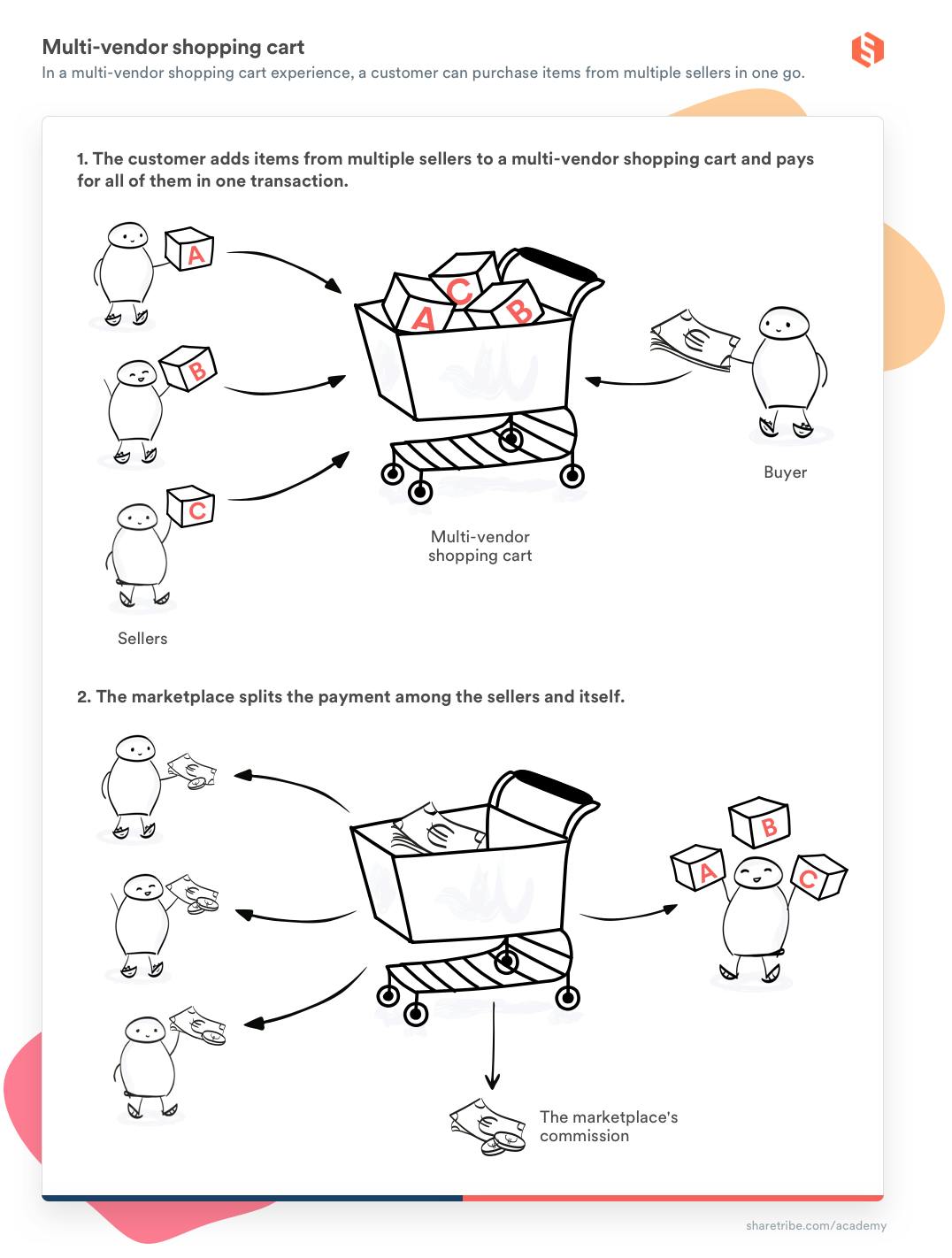
While many online marketplaces have a multi-vendor shopping cart, there are just as many that don't. It's not a given that your marketplace needs or would even benefit from having a shopping cart experience.
Many aspiring marketplace entrepreneurs, especially those with experience running their own online store, assume that a multi-vendor shopping cart is a must-have on their marketplace as well. Though sometimes building a cart is the right call from the very beginning, other times it can be postponed until later. Then there are cases where a shopping cart is completely unnecessary or would only complicate the customer experience.
A marketplace type where a shopping cart is unnecessary is a rental or service marketplace where the customers need to be physically present for the service. You can only be in one Uber at a time, so it doesn't really make sense to order many rides at once. Similarly, you probably don't want to distribute a single night's stay between multiple Airbnb apartments.
There are also some marketplaces where, even if it would technically make sense to purchase multiple products in one go, it rarely (if ever) happens. For example, on a marketplace for selling expensive pieces of art or collectibles, most transactions will only involve one product. In such scenarios, a shopping cart experience only makes the purchase process more complex. An "Add to cart" button means an extra step in the checkout experience as opposed to a simpler "Buy now" flow.
Extra steps can lead to a loss of sales. The complexity of the checkout process is one of the top reasons for cart abandonment. It's best to design a transaction flow that has as few steps as possible.
If you expect your typical customer to buy multiple products in one go, the next question is whether you expect them to buy from one or multiple vendors. You might be better off building a single-vendor shopping cart on your multi-vendor marketplace.
Food delivery platforms like DoorDash and Deliveroo are typical examples of this type of checkout flow: they allow you to add multiple dishes from the same restaurant to your order, but to order from two different restaurants, you need to make separate orders. Accepting this limitation has allowed Doordash, Deliveroo, and other similar platforms to design a smooth checkout and delivery experience.
Even if you expect a typical customer to want to purchase from multiple vendors in a single session, the cart experience is not an obvious best solution. An increasingly large portion of e-commerce is happening on mobile, and many marketplaces have opted for a simpler "Buy now" experience.
Typical examples of this are secondhand clothing marketplaces. Vinted and Depop, two European unicorn marketplaces, have never had a shopping cart. Instead, if you want to buy a piece of clothing on these platforms, you click "Buy now" and confirm your purchase immediately. If you want to buy multiple items, even from the same seller, you simply click "Buy now" multiple times.
It's important to note that Vinted and Depop do not offer guest checkout. Every customer needs to sign up to the platform before they're allowed to complete a purchase.
Guest checkout on online marketplaces is another complex topic, and it deserves its own dedicated post. For now, I predict that many marketplace platforms will question if a shopping cart really offers an optimal customer experience. A combination of no guest checkout and no shopping carts will likely become more and more commonplace in the future.
There are many reasons not to build a multi-vendor shopping cart, but for some marketplaces, it can be necessary to offer the best possible user experience. One such scenario is when you expect a significant number of buyers to purchase products from multiple sellers in one session and to do so via guest checkout. Without a multi-vendor shopping cart, they would have to type in their credit card details, shipping address, and other required information once per product. For example, marketplace giants eBay and Etsy both offer a guest checkout option.
Another benefit of a shopping cart is that it makes it easier to offer things like discounts for purchasing multiple items or coupons that give you a 10% discount on your total order. Platforms that opt for the "Buy now" flow are more limited in their discount options.
In addition, if your marketplace handles logistics, there are benefits to having all products under the same order. This is likely the main reason that Amazon, the world's largest marketplace, has a shopping cart experience, even though it doesn't offer guest checkout.
So if you need a multi-vendor shopping cart, read on. In the next section, I discuss the challenges you'll need to solve or at least mitigate if you want to build one.
The concept of a multi-vendor shopping cart sounds simple, but the more you think about the details, the more complex it gets. A shopping cart experience may have to take into account shipping options, discount codes, order changes, different commissions, currency, and split payouts. Below, I share an example of a checkout flow that includes all of these steps.
Let's say a customer adds three products to their shopping cart on your marketplace: one from Seller A and two from Seller B. The checkout flow needs to include and handle the following.
The customer is in France and wants their order shipped there. Seller A is in Switzerland and ships to all EU countries with DHL. Seller B is based in the United States and ships globally via FedEx and UPS.
There are no shipping providers that would cater to both Seller A and Seller B. The customer needs to choose a different provider per vendor, which brings extra steps to the checkout flow.
The customer has two discount codes:
- A code they received from the marketplace. It offers 10% off the total order sum if you buy two products or more.
- A seller-specific code for Seller B. Seller B offers a one-time code for $5 off orders over $20.
What kind of user interface does the marketplace have to enter the codes? Can the customer use both codes or just one? If not, how will they choose which code they want to use?
After making the purchase, the customer notices a product they ordered from Seller B is too small. They ask Seller B to switch the product to the correct size, which has a higher item cost. The order total and discount amount need to be changed.
Seller A is just starting out, so the marketplace charges them a standard seller commission of 10%. Seller B is more established and doing great in sales. The marketplace has rewarded them with a reduced commission of 8%.
The customer wants to pay in euros. Seller A expects to receive payouts in Swiss francs, Seller B in US dollars.
Eventually, the marketplace needs to figure out how to calculate the payouts. How much should Seller A, Seller B, and the marketplace receive?
The calculation needs to take into account:
- Shipping rates
- Discounts
- Changes in the order total
- Different commissions
- Different payout currencies.
It's safe to say that the algorithm required to make the calculations needs to be quite complex. Developing such a system can be a considerable investment.
Additional questions come from if your marketplace payment provider will be able to accommodate this payout logic.
For example, Stripe Connect (perhaps the most popular global payment solution for marketplaces) assumes that each transaction payout is split between two parties: the seller and the marketplace.
For more complex cases where payouts are split between multiple parties, Stripe has a feature called separate charges and transfers. However, this feature is only available if the platform and seller are in the same region. Since Europe and the US are two different regions, in our example scenario, the marketplace operator is out of luck. Stripe cannot accommodate what they need, so they have to find another provider or simplify their checkout process.
This poses a problem for an aspiring marketplace entrepreneur. If it's not possible to build a perfect solution from the beginning, what to do? In this section, I'll discuss four ways to move forward with a multi-vendor shopping cart.
If something is difficult to automate, a good solution can be to validate your concept manually before investing in development. For an early-stage MVP marketplace, this could mean building a simple flow, where the entire payment goes to your own bank account. You then manually calculate the payout to each seller and transfer the money.
There are situations where this can be the right approach. Manually processing payouts allows you to figure out if your idea has wings while offering an optimal checkout experience for your customers. However, you need to be aware of two caveats.
Firstly, as exemplified above, the calculations are quite complex. Doing them manually in a spreadsheet can lead to errors. If your sales volume suddenly goes up a lot, you might face challenges scaling the manual approach quickly enough, which can put your business in jeopardy.
Secondly, depending on your approach and local jurisdiction, processing payments through your personal account can be illegal. You might be considered a provider of an escrow service: temporarily holding money that belongs to another. And if your marketplace faces a cash flow issue, you might not be able to pay your sellers for the products or services they already delivered.
Providing escrow services is heavily regulated in most countries, and you often need to have a proper license for it. For a large marketplace like Etsy or eBay, obtaining such a license is feasible, but for most early-stage marketplaces, it's prohibitively expensive.
This is one of the main reasons why most marketplaces use services like Stripe Connect, which automate payout splitting and guarantee compliance with regulation. If you're considering this approach, I strongly recommend consulting a local lawyer to make sure it's something you're allowed to do.
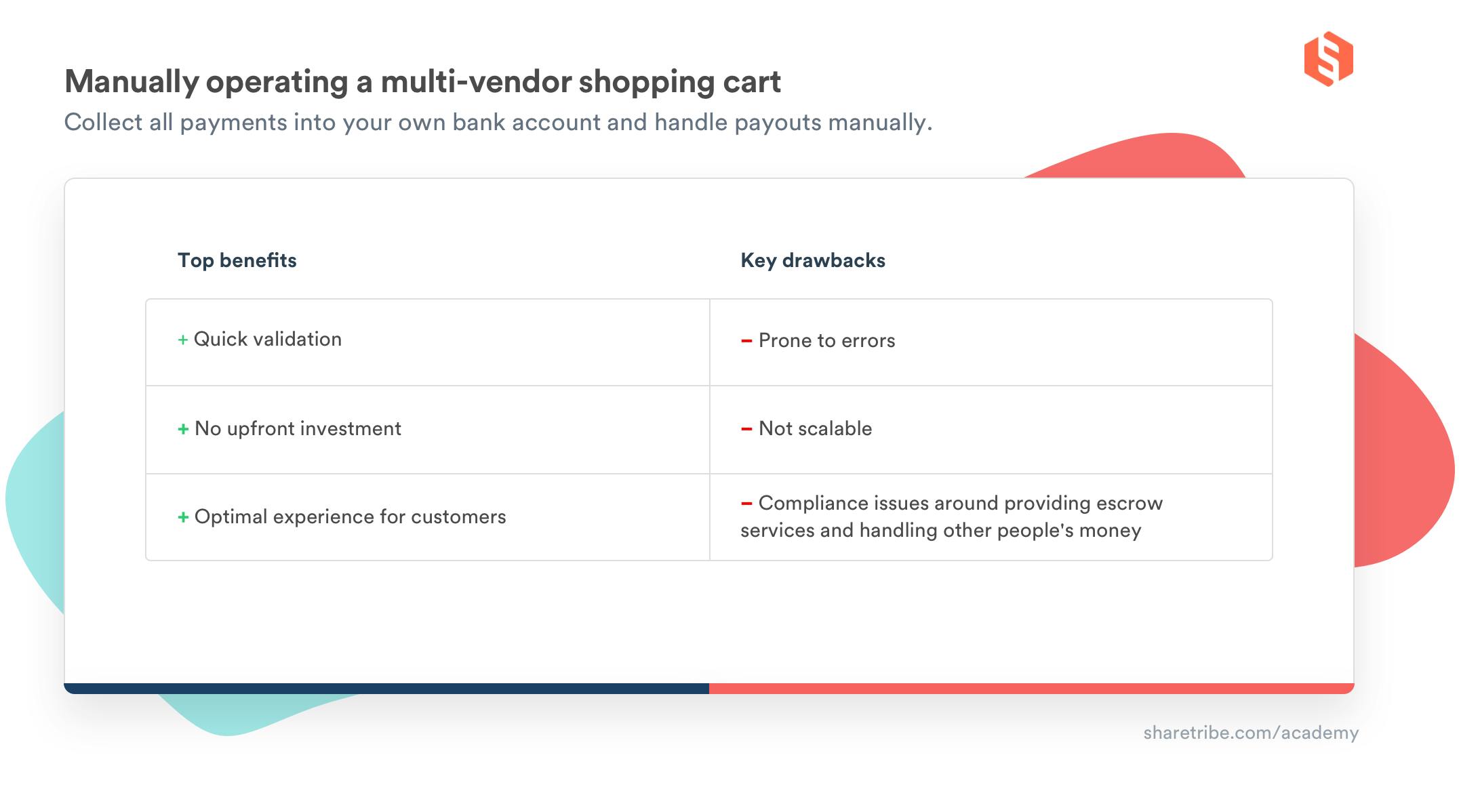
If handling payouts manually is not an option for you, an alternative is to compromise on the simplicity of the user experience and create a multi-vendor shopping cart with single-vendor checkout. In practice, this means that the customer can see all the items in one cart, but they are grouped by vendor. The customer checks out once per vendor instead of per cart. Shopify's marketplace kit uses this approach. Purchasing products from multiple vendors at once is not possible due to limitations in Shopify's checkout API.
While the single-vendor checkout approach can improve the customer experience over no cart at all, it doesn't solve everything. If you allow checking out as a guest, any customer who isn't signed in needs to enter their information multiple times. Coupons offering discounts for buying multiple products are not possible.
In the end, the benefits of a multi-vendor shopping cart with single-vendor checkout are limited.
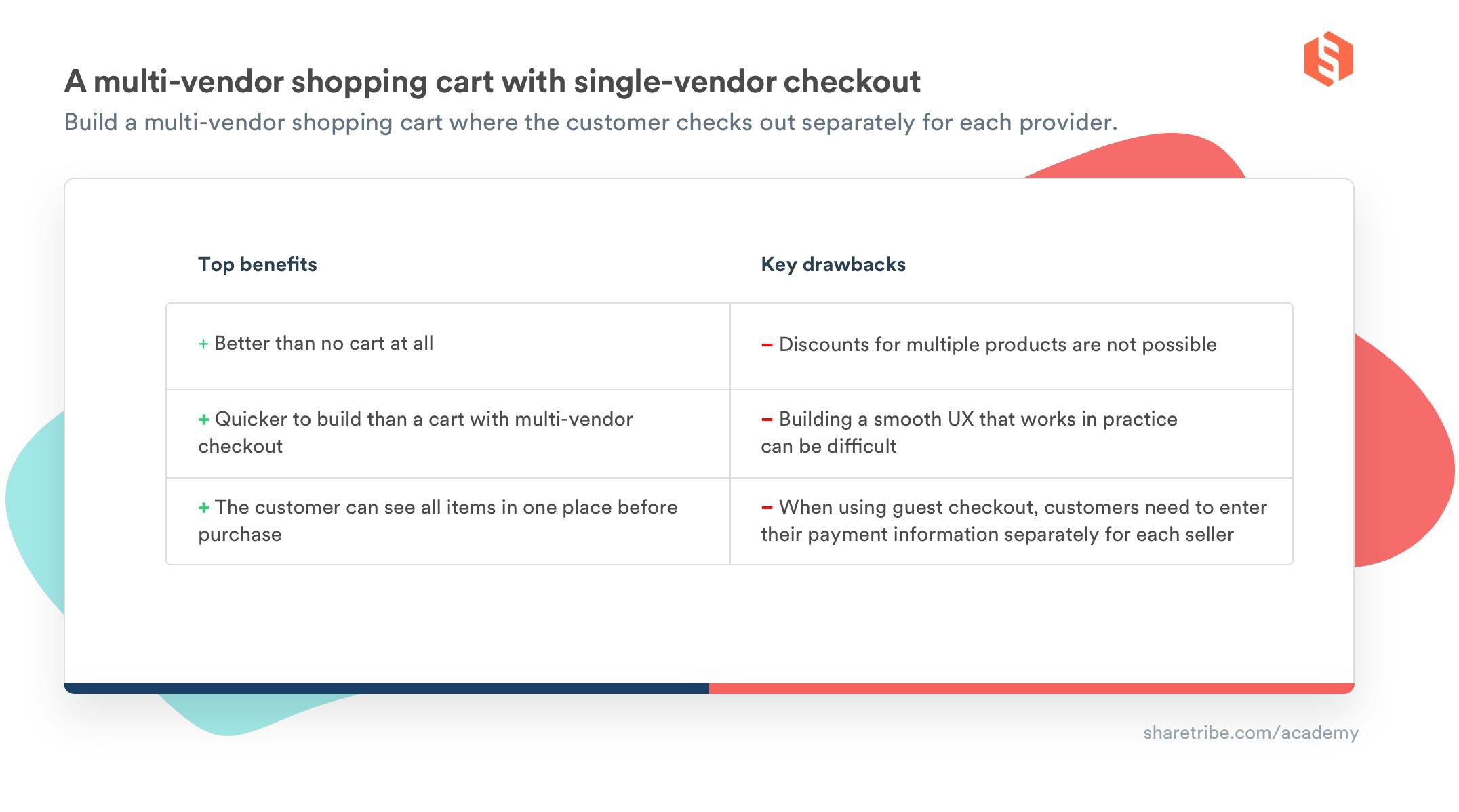
A variation to the approach above is to have a shopping cart where each seller's items are still bought separately, but each transaction happens separately under the hood. The customer enters their payment information only once, after which the marketplace initiates multiple transactions on their card behind the scenes. Essentially, you would be hiding the fact that you're completing multiple checkouts at once.
This solves the issue with Stripe and improves the guest checkout experience. However, while initiating multiple transactions this way might work on a technical level, it comes with some obvious risks. Banks become suspicious if a credit card is charged multiple times in a row, flagging the charges as potentially fraudulent. I've seen situations where banks have blocked transactions from marketplaces that use this approach. Thus, it's not really an approach I can recommend.
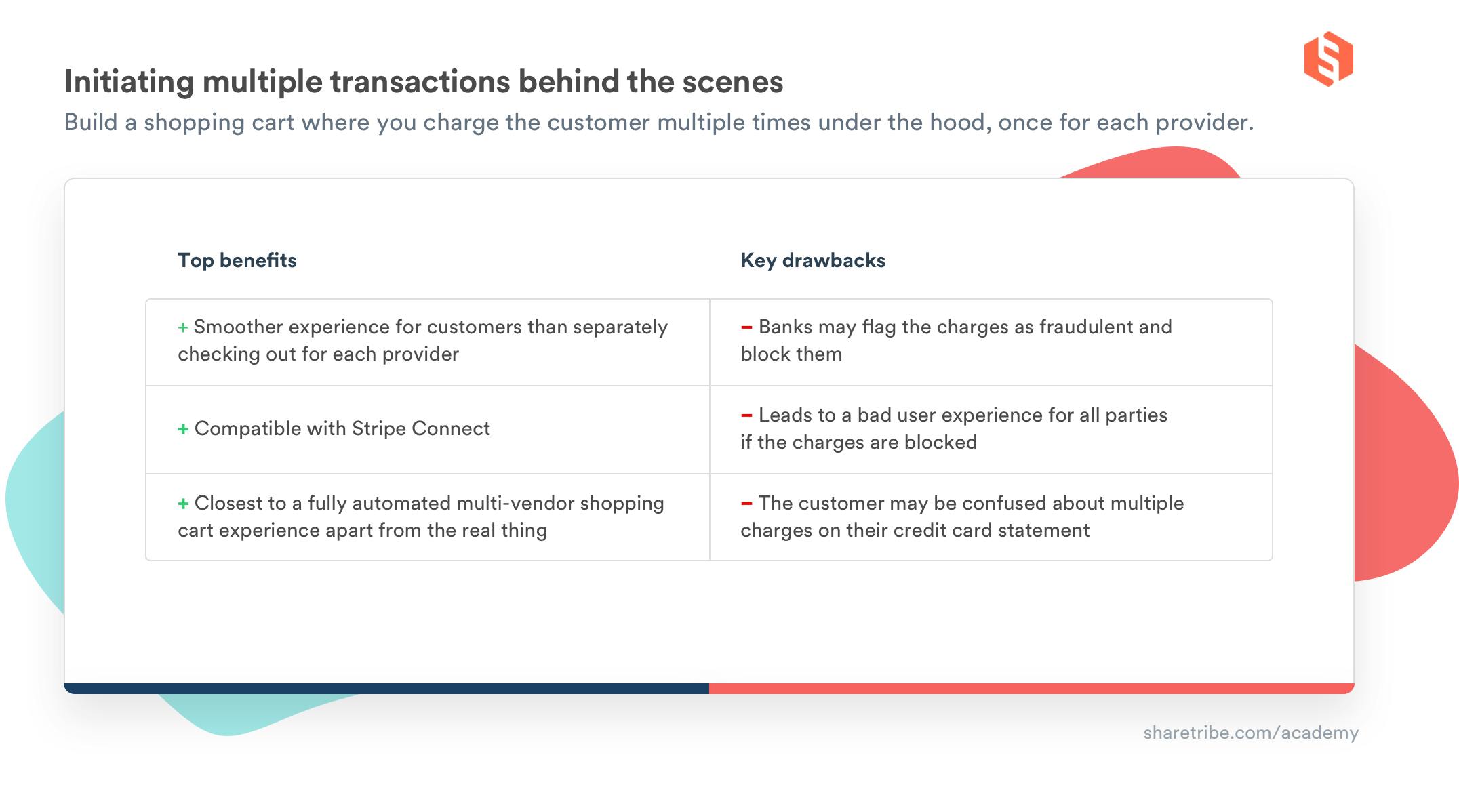
If building a full multi-vendor shopping cart is a must-have for you, and none of the earlier approaches work, you need to bite the bullet and invest the time and resources to build a fully automated setup.
The first thing to do is to choose the right payment provider. You need to make sure they support this use case.
I'm currently aware of just one payment provider that can handle this type of checkout flow and is accessible to early-stage marketplaces: Mangopay. However, the downside of Mangopay is that it's currently only available for marketplaces based in Europe.
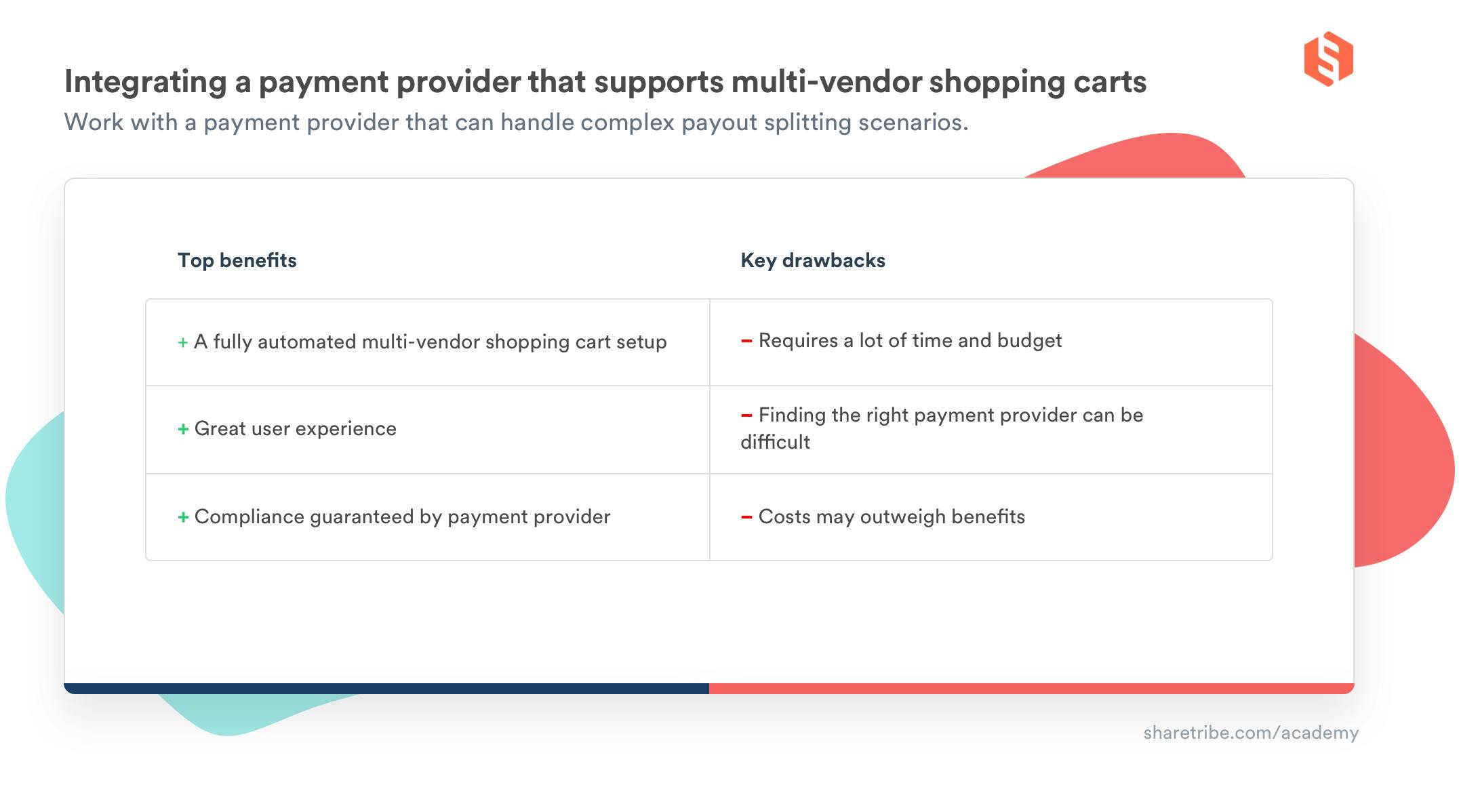
If you're working with Sharetribe's marketplace software, there are multiple different approaches you can take to building a multi-vendor shopping cart.
By default, Sharetribe has a "Buy now" checkout flow, available out of the box. This is my go-to recommendation for nearly all early-stage marketplaces. Even if your marketplace would benefit from a shopping cart experience eventually, it's rarely necessary in the very beginning.
If offering a multi-vendor shopping cart experience is a must-have for your platform, Sharetribe allows you to custom-develop any of the checkout flows described in this article. Building a multi-vendor shopping cart with single-vendor checkout is quicker to build since it allows you to use Sharetribe's built-in Stripe integration. Building a fully automated setup where payouts are split automatically requires integrating a third-party payment gateway like Mangopay into your marketplace, which requires more time and budget.
👉 Here's our practical step-by-step guide to developing a multi-vendor shopping cart with Sharetribe.
In this article, you've learned about situations where having a multi-vendor shopping cart could benefit a marketplace.
In most cases, a multi-vendor shopping cart is not necessary. A "Buy now" flow can even be a better experience for your buyers. However, if you expect many of them to purchase multiple products at the same time and to check out as guests, a shopping cart experience can be an important part of your marketplace's checkout flow.
You've discovered why building a multi-vendor shopping cart is a complex process, and what you need to take into account when building one. You learned the different approaches to building a multi-vendor shopping cart and their pros and cons.
I hope that you now have a better understanding of this complex topic and are ready to make the right design choice for your marketplace.
Happy building!
You might also like...

How to design your marketplace transaction flow
The science behind minimal abandoned carts for marketplace platforms.
Start your 14-day free trial
Create a marketplace today!
- Launch quickly, without coding
- Extend infinitely
- Scale to any size
No credit card required
